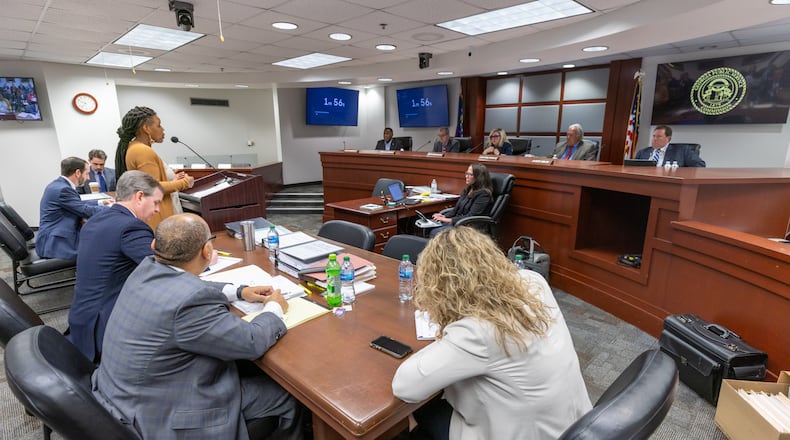Witnesses for Georgia Power, environmental groups and members of the public delivered their closing arguments this week before state utility regulators at the Georgia Public Service Commission (PSC) decide whether to approve or pare back a nearly 12% rate hike the company wants to impose on customers over the next three years.
With the PSC’s five elected members set to take a final vote on the plan on Dec. 20, this much is clear: The gap remains wide between the rate increase the company wants and what the commission’s own public interest staff and various interest groups say is necessary.
Over two long days of testimony, Georgia Power did not back away from the higher rates or the significant bump in its return on equity it has asked for. The hearings were testy at times, most notably when commission Chairman Tricia Pridemore scolded PSC attorneys, claiming some of their questions for Georgia Power staff were irrelevant, only to later ask why they weren’t interrogating other witnesses.
The stakes are high for Georgia Power and its 2.7 million customers. If approved, the new rates would raise the typical household’s annual electric bill by nearly $200 over the next three years, with the largest increase taking effect after the New Year. And that’s without considering other major rate bumps likely on the horizon, as the company seeks to recoup money spent on fuel burned at its power plants and to build the two delayed and over-budget nuclear reactors at Plant Vogtle. Once factored in, PSC staff have estimated those could add another $55 to $60 to the average customer’s monthly bill.
Here’s where things stands ahead of the final vote.
Profit sharing controversy
The hearings began with an issue central to Georgia Power’s rate case: its request to raise the return on equity the company — and shareholders of its parent, Southern Company — receive from capital investments.
Georgia Power wants to keep the ceiling at 12% and hold onto a share of profits that exceed it, while increasing the target return on equity from 10.5% to 11%. The PSC’s public interest staff, meanwhile, has recommended lowering the upper boundary from 12% to 10.5% and requiring all profits above that limit go back to ratepayers.
Georgia Power witnesses did not mince words in sharing their views on the PSC staff’s proposal, at various times calling the alternate plan “ill-advised,” “radical” and “unacceptable to the company.”
Credit: AJC file photo
Credit: AJC file photo
Staff pointed out that Georgia Power’s return on equity is already well above the national median for similar utilities, according to Fitch Ratings. Analysis by the Solar Energy Industries Association (SEIA) presented to the commission also shows that over the last 11 years, the company has collected $1.87 billion above its approved return target.
Despite earning more than $850 million in profit last quarter, Georgia Power maintained that dialing back its authorized returns would harm its financial picture.
“Now is not the time to chart a drastically new course for the regulatory framework in Georgia,” the company’s chief financial officer Aaron Abramovitz said.
‘Smart Usage” rate under the microscope
As in past hearings, Georgia Power’s plan to place more customers on a complicated — and often more expensive — rate plan again drew criticism from consumer advocates and one of the PSC commissioners.
The company’s “Smart Usage” rate plan has been the default for new housing built since Jan. 1, 2021. To give customers an incentive to use energy at times of lower demand, the plan charges households much higher energy rates during peak use periods. The idea is that by pushing customers not to run major appliances at times of increased demand, they’ll reduce strain on the electric grid and save money.
But witnesses testified that customers rarely understand how the plan works and presented evidence showing that in reality, most customers — especially those who use less energy — pay more on the rate than they would on one of the company’s other plans.
Georgia Power continued to push to do away with its standard residential rate plan and make “Smart Usage” the default for all new rooftop solar customers starting next year. But at least one commissioner, PSC Vice Chairman Tim Echols, appeared opposed to that plan.
“We tried this, it didn’t perform — at least to my liking —and I think we need to go back to the drawing board before we make it mandatory,” Echols said.
Rooftop solar uncertainty persists
Solar is seen as a key pathway to reduce the climate change impact of Georgia’s electricity sector, but the fate of a popular rooftop solar program is still up in the air ahead of the commission’s final vote.
A pilot “net metering” program created in 2019 by the PSC allowed customers with rooftop solar to be credited at a higher rate for excess electrons sent back to the grid, allowing participants to cut their bills dramatically. But the program was capped at 5,000 participants and enrollment has been closed since last summer.
Georgia Power has consistently opposed reopening the program and said its analysis shows net metering participants cost more to serve than other customers.
“... Monthly netting ... allows these customers to shift the costs to build, operate, and maintain the electric system onto non-participating customers,” Georgia Power witnesses said in filed testimony.
Solar proponents disagree, claiming the company’s analyses are inadequate and that program participants actually reduce demand on the grid at peak times and cost less to serve.
Several commissioners had questions for witnesses about the effects of potentially growing the program, but Echols — whose proposal this summer to expand the program failed to pass — again seemed the most interested in allowing new enrollees.
“We created a kiddie pool with 5,000 (customers) in 2019,” Echols said. “I’m not for just throwing our state into the deep end of the pool where the swimming wolves are ... Let’s just keep experimenting with this in the Georgia way.”
About the Author
The Latest
Featured




